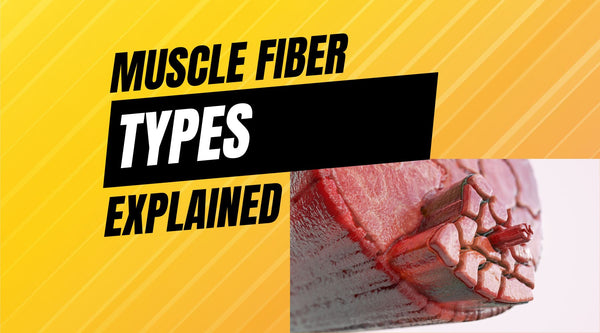Muscle Fibers: Types, Differences, and Their Impact on Performance
When you think about crushing a workout, muscle fibers probably aren’t the first thing that comes to mind—but maybe they should be! These microscopic powerhouses are the key players when it comes to strength, endurance, and overall performance.
Whether you're a pro athlete or just an everyday gym-goer, understanding the different types of muscle fibers and how they work can help you fine-tune your training for better results. Let’s break down the types of muscle fibers, their differences, and how they impact your performance in the gym, on the track, or in the pool.
What Are Muscle Fibers?
Muscle fibers are the tiny contractile units inside your muscles that work together to generate force and movement. Each muscle in your body is packed with thousands of these fibers, bundled into groups that make up the muscle tissue itself. There are two main types of muscle fibers: Type I (slow-twitch) and Type II (fast-twitch), each playing a unique role in how your body handles different kinds of exercise.
Type I Muscle Fibers: The Endurance Machines
Characteristics:
Type I fibers, better known as slow-twitch fibers, are built for endurance. They’re the go-to muscle fibers for long, steady activities like distance running or cycling. They contract more slowly than fast-twitch fibers, but the trade-off is they can keep going for longer without getting tired. Here’s what sets them apart:
- Oxidative Power: Type I fibers are aerobic beasts, using oxygen efficiently to generate energy.
- Mitochondria-Dense: Packed with mitochondria (the cell’s energy powerhouses), they’re perfect for long bouts of exercise.
- Capillary-Rich: These fibers are well-supplied with oxygen thanks to a dense network of capillaries.
- Fatigue-Resistant: Their oxidative efficiency means they can go hard for a long time without wearing out.
Best for:
Type I fibers dominate in endurance activities that require prolonged effort. Think:
- Long-distance running
- Cycling
- Swimming
- Rowing
- Hiking
Type II Muscle Fibers: The Strength and Power Generators
If Type I fibers are the marathoners, Type II fibers are the sprinters. Known as fast-twitch fibers, they’re all about speed and power. Type II fibers contract more quickly than Type I fibers but fatigue a lot faster. They come in two flavors: Type IIa and Type IIb (or IIx).
Type IIa Muscle Fibers: The Hybrid Workhorse
These fibers are the middle ground, combining endurance with speed and power. They’re like the Swiss Army knife of muscle fibers, able to handle both aerobic and anaerobic work.
- Moderate Oxidative Capacity: Type IIa fibers can use oxygen for energy but also tap into anaerobic energy when needed.
- Glycolytic Capacity: They’re good at breaking down glucose without oxygen, giving them a quick burst of energy.
- Fast Contraction Speed: Faster than Type I, but not as explosive as Type IIb fibers.
- Versatile: These fibers can support a mix of endurance and power-based activities.
Best for:
Type IIa fibers kick in for activities that demand both endurance and power. Examples include:
- Middle-distance running (800m to 1500m)
- High-intensity interval training (HIIT)
- Sports like soccer or basketball, where repeated bursts of effort are key
Type IIb Muscle Fibers: The Power Kings
Type IIb fibers are all about raw power and speed. They’re the muscle fibers that get activated during those explosive, short-duration movements, like sprinting or lifting heavy weights. But they come with a catch—they fatigue quickly.
- Low Oxidative Capacity: These fibers rely on anaerobic energy, meaning they don’t need oxygen to produce power.
- High Glycolytic Capacity: They’re great at quickly breaking down glucose for energy.
- Explosive Contraction Speed: These fibers fire off faster than any other, giving you that max burst of power.
- Fatigue Fast: After all that explosive energy, they need more time to recover.
Best for:
Type IIb fibers are your go-to for short, all-out efforts like:
- Sprinting (100m or 200m)
- Olympic weightlifting
- Powerlifting
- Plyometrics
Muscle Fiber Composition and Athletic Performance
Your unique muscle fiber composition—the mix of Type I and Type II fibers you have—plays a huge role in how you perform. Genetics largely determine this, with some people being naturally more suited for endurance sports, while others are built for strength and power.
Genetic Influence
You can thank your parents for the muscle fiber ratio you were born with. Some athletes naturally have more Type I fibers, making them ideal for endurance sports like long-distance running. Others might be stacked with Type II fibers, giving them an edge in strength and power sports.
Training Adaptations
Here’s the good news: training can influence your muscle fibers! While you can’t completely turn a Type I fiber into a Type II, you can shift their characteristics. Endurance training can make Type IIa fibers more fatigue-resistant, while strength training can increase the size and power of Type II fibers.
How to Train for Different Muscle Fiber Types
Once you know how your muscle fibers work, you can tweak your training to maximize your results.
Training for Type I Muscle Fibers
To develop Type I fibers, focus on endurance and high-volume work. Here’s how:
- Endurance Training: Long runs, cycling, or swimming sessions are key.
- High-Rep, Low-Weight: Aim for sets of 15-20 reps to build muscular endurance.
- Steady-State Cardio: Keep your cardio sessions around 30 minutes or longer to boost aerobic conditioning.
Training for Type II Muscle Fibers
To tap into your fast-twitch power, go for high-intensity, short-burst exercises:
- Strength Training: Use moderate-to-heavy weights with sets of 6-12 reps for Type IIa and 1-5 reps for Type IIb.
- Plyometrics: Explosive moves like jump squats and box jumps are perfect for developing Type II fibers.
- Sprint Training: Throw in sprints to activate those fast-twitch fibers.
- HIIT: High-intensity intervals challenge both Type IIa and Type IIb fibers.
Muscle Fibers in Different Sports
Different sports demand different things from your muscle fibers. Here’s how it breaks down:
Endurance Sports
Sports like distance running, cycling, and swimming are all about Type I fibers. Athletes in these sports have a higher proportion of slow-twitch fibers for sustained, aerobic energy production.
Power and Strength Sports
On the flip side, sprinting, weightlifting, and powerlifting rely heavily on Type II fibers. These fast-twitch fibers deliver the explosive power needed for short, intense efforts.
Mixed Sports
In sports like soccer, basketball, or tennis, you need both endurance and power. That’s where having a balanced mix of Type I and Type II fibers comes in handy, giving you the stamina for long games and the burst of speed for quick plays.
Wrapping It Up
Understanding your muscle fiber composition can help you train smarter, not harder. Whether you’re chasing endurance gains, building explosive strength, or working on a mix of both, tailor your training to maximize your results. Remember, you’ve got both endurance and power built into your muscles—it’s up to you to activate them!
About The Author
Matt Mosman (MS, CISSN, CSCS) is a research scientist, endurance athlete, and the founder of the supplement company Simply Good Supplements. Matt holds his B.S. in Exercise Science from Creighton University and his M.S. in Exercise Physiology from the University of California. Matt and his family reside in Spearfish South Dakota, where they enjoy running, mountain biking, camping, and all the outdoor adventures Spearfish has to offer.
References:- Kreider, R. B., Kalman, D. S., Antonio, J., Ziegenfuss, T. N., Wildman, R., Collins, R., ... & Lopez, H. L. (2017). International Society of Sports Nutrition position stand: safety and efficacy of creatine supplementation in exercise, sport, and medicine. Journal of the International Society of Sports Nutrition, 14(1), 18.
- Volek, J. S., Duncan, N. D., Mazzetti, S. A., Staron, R. S., Putukian, M., Gomez, A. L., ... & Kraemer, W. J. (1999). Performance and muscle fiber adaptations to creatine supplementation and heavy resistance training. Medicine and Science in Sports and Exercise, 31(8), 1147-1156.
- Andersen, J. L., & Aagaard, P. (2000). Myosin heavy chain IIX overshoot in human skeletal muscle. Muscle & Nerve: Official Journal of the American Association of Electrodiagnostic Medicine, 23(7), 1095-1104.
- Bottinelli, R., & Reggiani, C. (2000). Human skeletal muscle fibres: molecular and functional diversity. Progress in Biophysics and Molecular Biology, 73(2-4), 195-262.
- Costill, D. L., Daniels, J., Evans, W., Fink, W., Krahenbuhl, G., & Saltin, B. (1976). Skeletal muscle enzymes and fiber composition in male and female track athletes. Journal of Applied Physiology, 40(2), 149-154.


